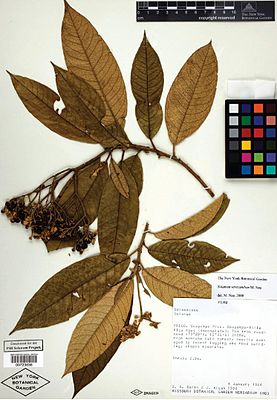Solanum oxapampense
| Solanum oxapampense | ||||||||||||
|---|---|---|---|---|---|---|---|---|---|---|---|---|

Isotype of Solanum oxapampense |
||||||||||||
| Systematics | ||||||||||||
|
||||||||||||
| Scientific name | ||||||||||||
| Solanum oxapampense | ||||||||||||
| S.Knapp |
Solanum oxapampense is a species ofthe nightshade family (Solanaceae). It was first described in 2010 and is endemic tocentral Peru.
description
Solanum oxapampense grows as a small tree with heights of 2.5 to 9, in exceptional cases it can reach up to 18 meters. The trunk branches only in the upper part and is densely covered with trichomes . The shield-shaped trichomes are 0.2 to 0.4 millimeters long, stand in twenty to thirty rows and are dark red-brown in the middle. The young shoots are densely covered with shield-shaped trichomes, which are similar to those of the trunk and turn pale beige when they dry out. The bark of older trunks is pale brown in color due to the trichomes.
The sympodial units contain several leaves . The simple leaves are between 6.5 and 16 inches long and between 2 and 5 inches wide. The leather-like leaf blade is approximately elliptical in shape. Its base, like the tip, is pointed and its bent-back leaf margins are entire. The hairless upper side of the leaf is glossy dark green in color and turns dark olive green when it dries out. The underside of the leaf is covered with shield-shaped, more than twenty-row trichomes, which can be up to 0.5 millimeters thick. From the leaf axis 16 to 20 pairs of primary leaf veins go off, which are densely hairy on the underside of the leaf. The petiole, 0.6 to 2 centimeters long, is densely covered with shield-shaped trichomes.
The inflorescences are terminal on the stems. They are 8 to 15 centimeters long and are branched in many ways. Each of the inflorescences consists of 60 or more flowers. The inflorescence is densely hairy with shield-shaped trichomes, which are similar to those of the trunk. The flower stalk , nodding at flowering time , is 3 to 6 centimeters long and about 1.5 millimeters thick at the base and about 2 millimeters thick at the top. It is densely covered with trichomes and bent like a joint at the base. The flower stalks are 5 to 8 millimeters long and about 1 millimeter apart.
The five-fold flowers are always fully developed. The cup-shaped calyx tube is between 1.5 and 2 millimeters long and covered with 1.5 to 2 millimeters long, triangular lobes. The dense hair on the underside of the calyx resembles that of the rest of the inflorescence, while the top of the calyx is only sparsely hairy. The white crown measures 1.2 to 1.5 centimeters in diameter and is lobed in a star shape up to three quarters of the way to the base. The corolla lobes are 6 to 7 millimeters long and 4 to 4.5 millimeters wide, and their edges and tips are densely hairy. The top of the corolla lobes is hairless, while the underside is densely covered with shield-shaped, more than twenty-row trichomes. The hairless stamens have grown together to form a tube and the free-standing part is between 1 and 1.5 millimeters long. The yellow anthers are elliptical in shape with a length of 3 to 4 millimeters and a width of 1 to 1.5 millimeters. They open through pores at the tips, which enlarge into slits with age. The ovary is densely hairy with branching trichomes. The stylus is 9 to 9.5 millimeters long and densely covered with branching, four- to thirty-row trichomes, which are about 0.2 millimeters long. The head-shaped stigma is finely papillary and colored light green in young plants.
As fruits are ripe, green colored berries are formed, which are spherical with a diameter of 0.6 to 0.7 centimeters. The unevenly occupied with branching trichomes pericarp acts schorfartig is thin and not shiny. The berries are on a lignified, more or less upright stem that is 1 to 1.1 centimeters long and about 1.5 millimeters thick at the base. Each of the berries contains 40 to 50 reddish to golden brown seeds. These are flat-kidney-shaped with a length of 0.9 to 1 millimeter and a width of 0.9 to 1 millimeter and have a finely grained surface.
distribution and habitat
So far Solanum oxapampense has only been found in the valley of the Rio Huancabamba in central Peru . There it occurs in the Yanachaga Chemillén National Park . The species thrives at altitudes of 1500 to 2500 meters, where it grows in mountain forests. They are mainly found along paths and in open terrain, often together with other nightshades ( Solanum ) from the Brevantherum clade .
Systematics
It was first described as Solanum oxapampense in 2010 by Sandra Knapp in PhytoKeys number 1, page 42. The specific epithet oxapampense refers to the Peruvian province of Oxapampa , where the species is endemic .
swell
- Sandra Knapp: New species of Solanum (Solanaceae) from Peru and Ecuador . In: PhytoKeys . No. 1 , 2010, ISSN 1314-2003 , p. 42-45 , doi : 10.3897 / phytokeys.1.659 .
Individual evidence
- ↑ a b c d e f g Sandra Knapp: New species of Solanum (Solanaceae) from Peru and Ecuador . In: PhytoKeys . No. 1 , 2010, ISSN 1314-2003 , p. 42-45 , doi : 10.3897 / phytokeys.1.659 .
- ↑ Solanum oxapampense. In: The International Plant Names Index. www.ipni.org, accessed February 9, 2013 .